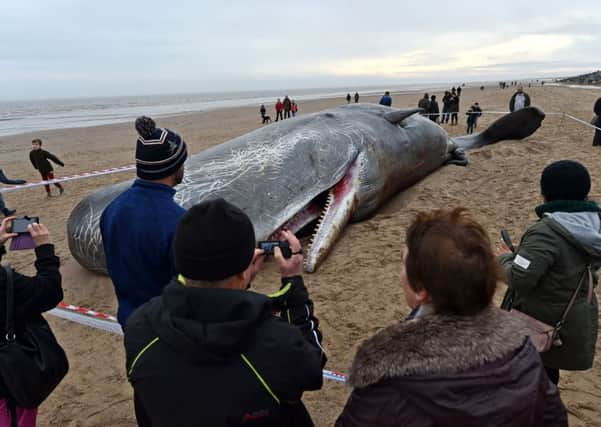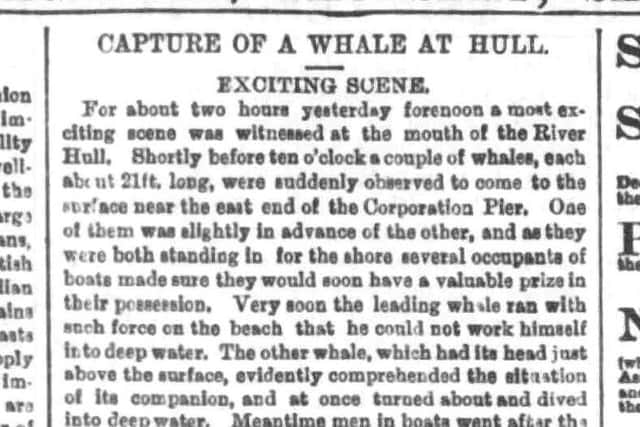Sympathy rather than plunder for beached whales


These days there is a palpable bond between humans and these great creatures, mammals like us and with a perceived high degree of intelligence. We hate to see them suffer and die from the multiple internal injuries from which they stand no chance of recovery.
But it has not always been this way.
In the past these massive slow moving aquatic beasts were killed en masse to provide a huge quantity of meat and oil.


Advertisement
Hide AdAdvertisement
Hide AdFor many decades whales of all species were mechanically slaughtered almost to the point of extinction before the edge of the precipice loomed ahead and hunting regulations came into force in 1946 followed by a moratorium in 1982.
This unemotional and objective attitude towards whales also applied to those animals that became stranded on our shores in times gone by as these accounts from our archive show.
In August 1868 there was this account in the Leeds Intelligencer of a small school of bottle nosed whales that visited the shallows at Redcar.
“Speedily boats were manned and attempts made to shoot the monsters, as it was nearly low water, and they had got into the shallows. After a gallant fight, a rush of gore spouted forth from the dying creatures, and two were captured and brought on shore by the fishermen.The water for a very considerable distance was tinged with crimson, and the scene was witnessed with great interest and excitement by crowds of visitors and inhabitants.”


Advertisement
Hide AdAdvertisement
Hide AdAn unfriendly reception to say the least and in September 1879 there was this extraordinary and harrowing account of the attempts to kill two 21ft. whales that had strayed too close the the Corporation Pier at the mouth of the River Hull.
One of these animals ended up beaching after several boats had set out after the “prize” and there were frantic attempts to harpoon the animal to death before the rising tide provided a possible escape.
“One well-directed throw was buried deep in the whale’s body. Then followed a scene of the most Intense excitement, A stream of blood shot out and reddened the water for yards round. At the same time the fish “spouted” violently, and beat the water with tall and fins in such a manner that the occupants of boats close by were drenched to the skin. The huge body writhed in evident agony, and his movements were so forcible that at length the chain by which his tall was bound snapped in two. The forward mooring line quickly followed, and the whale then instinctively made for deep water.”
Subsequently the monster was seen come to the surface, and several boats put off, when it was found to quite dead. A hawser was attached, and it was towed safely into the river Hull.”
Advertisement
Hide AdAdvertisement
Hide AdThe fact is that our attitude towards animals of even the simplest type has changed dramatically over the decades and as the twentieth century moved forward so did our attitude towards the sad beaching of these marine behemoths.
In 1937 a big sperm whale washed up at Bridlington was seen as more of a nuisance than something to be set upon and butchered.
Even so there was still plunder to be had and 300 gallons of oil were removed from the carcass after it was given by the council to a private individual.
Bridlington was again the scene of another sperm whale stranding in 1942 and it was noted at the time that beached whales were officially classed as “shipwrecks” which in some ways gave them a closer bond to humans which has strengthened as the years have worn on.
Advertisement
Hide AdAdvertisement
Hide AdIn 1953 there was this report in the Yorkshire Post which showed a more scientific approach to the phenomenon.
“Hundreds of holidaymakers at Spurn Point went down to the shore yesterday to look at a 27ft. dead whale which had been washed up.
The Natural History Museum in London was informed and it is probable that specimens will be taken from the whale. No arrangements have yet been made for its removal.”
The Natural History Museum? Certainly a far cry from the blood lust and opportunism of some eighty years earlier.
Advertisement
Hide AdAdvertisement
Hide AdMoving forward to this year and the remains of the unfortunate whales at Skegness were carefully dissected by marine biologists in front of curious onlookers to further research into why these things happen in the first place.
Whale beachings have always been a fact of life and there are many theories as to why it happens including links to global warming and industrial poisoning.
One thing is certain though. Today we treat dead and dying whales in a much more sympathetic way than our forebears did.